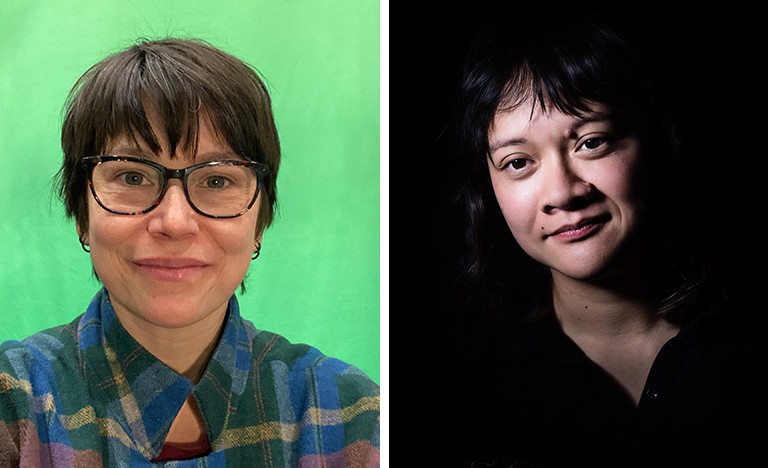This fall, Milieux’s porous outer membrane has stretched to accommodate a brand-new cluster: LePARC, the performing arts research cluster. This newest cluster’s faculty members — from the departments of contemporary dance, theatre, music, art education and English, build upon Milieux’s existing commitment to research creation and cross-disciplinary collaboration. LePARC, the Performing Arts Research Cluster. The cluster is co-directed by Angélique Willkie of the Department of Contemporary Dance, and Eldad Tsabary of the Department of Music.
Sandeep Bhagwati, a cluster member from the department of music, describes the new group as “a space for freewheeling and choreographed, cacophonic and harmonic, dramatic and sensible research-creation into the temporal-spatial convolutions of bodies, technologies and ideas.”
Particular threads of LePARC’s research-creation and scholarship include – but are by no means limited to – embodiment (the sensed and felt, the somatic, the gestured, the voiced, the virtuosic, the psychophysical), performance spaces (the intimate, the public, the spectacular, the shaped, the voluminous, the contained), and modes of transmission-of/engagement-with performance (the live, the receptive, the participatory, the dynamic, the ephemeral, the projected, the remembered).
This is hardly the first time members of this group have coalesced around a project; many faculty in LePARC have long histories of collaborating together in various combinations to explore co-creation and co-presentation.
LePARC is also Concordia’s first graduate-level research hub for the performing arts — and hopes to begin laying the groundwork for a formalized MFA in performance creation in the future. “The development of LePARC is something that I see as essential to the eventual emergence of an MFA performance creation program,” said Angélique Willkie in a recent conversation. “We thought, OK, we don’t have a graduate program, but we do have graduate students, and we’re all involved in research together. How do we bring our ideas together? LePARC is the opportunity to pull all of our research activities into a common focus.”
60×60, collaboration between departments across the Faculty of Fine Arts, invites students to create minute-long dance and music pieces. Numerous members of LePARC have worked on 60×60 productions.
Willkie, who is a contemporary dancer, dramaturge, and choreographer, remarked that for many of LePARC’s members, research-creation is an essential dimension of their teaching careers. “I’m an artist first, and university research supports my artistic creation. If I can’t practice, I can’t teach. It’s that simple.” Willkie’s artistic practice, and that of the other PARC members Sandeep Bhagwati, Mark Corwin, Eldad Tsabary and Ricardo Dal Farra in Music, Silvy Panet-Raymond in Contemporary Dance, Noah Drew, Ursula Neuerberg-Denzer, Shauna Janssen and Luis Sotelo in Theatre, MJ Thompson in Art Education and Louis Patrick Leroux in the English department, will build another bridge between research at Milieux and the world outside of Concordia.
“One of the advantages that the performing arts research community can bring to Milieux is that most of us are in contact with practice within our artistic communities. We have international connections. It gives Milieux the possibility to look into – even from a funding point of view — anchoring itself in performing arts research.” said Willkie. Given Montreal’s prominence in both the dance and music scenes in Canada, there will likely be many opportunities for Milieux researchers to expand our network outward.
How might LePARC collaborate across the existing Milieux clusters? Willkie hopes that the human body will offer a common focus. “One of the things that’s important for us is that we offer an approach to bodies in the society we live in. Bodies in movement, bodies in creative approaches to living, relationships to space, the way space is used. I’d like to encourage other clusters to think about playing around with bodies. It’s a place where we could meet that would enrich many areas of research focus.”

Numerous collaborations among LePARC’s members will be staged in the coming year. Among these is the Conversations in Dance Research colloquium this November organized by MJ Thompson and Angélique Willkie; the 4th International Conference on Technologies for Music Notation and Representation , organized by Sandeep Bhagwati, Ricardo Dal Farra, and Eldad Tsabary, in collaboration with Hexagram, McGill University, UQAM, and several Montreal music ensembles; the Montreal hub of the ICMPC15/ESCOM10 conference (International Conference for Music Perception & Cognition (ICMPC, their 15th conference) in conjunction with the European Society for Cognition in Music (ESCOM, their 10th) including cluster members Eldad Tsabary and Mark Corwin; and “Ecstasies of Influence,” led by Sandeep Bhagwati and co-investigators Angélique Willkie, Patrick Leroux, Noah Drew and Ricardo Dal Farra, an FRQSC research-creation grant project that looks at the transfer of creative processes between visual and theatrical arts and music.
“I hope that the new cluster will become a vibrant and intense contact zone between academia and the competitive and world-renowned community of professional performing arts in Montréal and beyond,” said Bhagwati. “As the current British PM would say: ‘Le PARC is Le PARC, and we’ll make a success of it.’”



